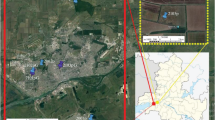Abstract
The mineralization rate of the 14C-labeled organic matter (OM) in the humus-accumulative AE horizon of a soddy-podzolic soil was determined in a laboratory experiment. The labeling was performed in a field experiment when microamounts of 14C-labeled glucose, glycine, and uracil were added to tree waste in sacks embedded in the upper layer of the forest litter. Samples containing 14C were taken from the AE horizon (above which the sacks with the labeled material were placed) 7 and 20 months after the beginning of the experiment. The soil samples were wetted to a water content corresponding to ∼80% of the total water capacity and placed in hermetic vessels containing vials with a periodically renewed alkali solution. The incubation was performed at room temperature for 3.5 months; the alkali solutions in the vials were replaced and titrated 12 times during this period. Mineralization curves were plotted from the amounts of carbon dioxide absorbed by a 0.3 N NaOH solution, which were calculated for each time interval; its 14C content was determined by the scintillation method. The experimental treatments also included the determination of the OM mineralization rate in material from the AE horizon pretreated with a heavy liquid or a heavy liquid and a 0.1 N NaOH solution. The differences between the mineralization rates of the labeled organic matter applied to the soil in the form of glucose, glycine, and uracil under the field conditions after the interaction for 7 and 20 months were revealed. The changes in the mineralization rate after the successive extraction of the labile organic matter with a heavy liquid and a 0.1 N NaOH solution were studied. It was shown that the transformation of the labeled low-molecular-weight organic compounds in the soil over 20 months included their strong inclusion into the humus composition, which was confirmed by the similar values of the mineralization constants of the native and 14C-labeled OM. In addition, the treatments with the heavy liquid or the heavy liquid and the NaOH solution had almost identical effects on the mineralization of the native and 14C-labeled OM. The mineralization constants of the native and 14C-labeled OM in the samples taken after 7 months of the field experiment differed significantly.
Similar content being viewed by others
References
I. A. Dudka, Methods of Experimental Mycology (Naukova dumka, Kiev, 1982) [in Russian].
I. V. Ivanov, L. S. Pesochina, and V. M. Semenov, “Biological Mineralization of Organic Matter in the Modern Virgin and Plowed Chernozems, Buried Chernozems, and Fossil Chernozems,” Eur. Soil Sci. 42(10), 1109–1119 (2009).
K. I. Kobak, Biotic Components of the Carbon Cycle (Gidrometizdat, Leningrad, 1988) [in Russian].
M. M. Kononova, Soil Organic Matter (Izd. Akad. Nauk SSSR, Moscow, 1963) [in Russian].
D. S. Orlov, O. N. Biryukova, and N. I. Sukhanova, Organic Matter of Soils of the Russian Federation (Nauka, Moscow, 1996) [in Russian].
A. V. Smagin, “The Gas Function of Soils,” Eur. Soil Sci. 33(10), 1061–1071 (2000).
S. Ya. Trofimov, P. Bottner, and M. M. Coateaux, “Decomposition of Organic Matter in Organic Horizons of Forest Soils in Laboratory Conditions,” Eur. Soil Scil. 31(12), 1349–1357 (1998).
Carbon in the Ecosystems of Russian Forest and Mires Ed. by V. A. Alekseev and R. A. Berdsi (Krasnoyarsk, 1994) [in Russian].
A. D. Fokin and O. S. Zhuravleva, “Seasonal Changes in the Transformation and Transportation of Uracyl, Glycine, and Glucose in Soils of Podzolic Type,” Eur. Soil Sci. 42(4), 378–384 (2009).
A. D. Fokin and A. I. Karpukhin, “Incorporation of the Products of Decomposition of Plant Residues Labeled with 14C into Humic Substances,” Pochvovedenie, No. 11, 72–78 (1974).
A. D. Fokin, A. A. Lur’e, and S. P. Torshin, Agricultural Radiology (Drofa, Moscow, 2005) [in Russian].
N. C. Brady and R. R. Weil, The Nature and Properties of Soils (Prentice Hall, New York, 2002).
E. M. Bridges and N. H. Batjes, “Soil Gaseous Emissions and Global Climate Change,” Geography 81(2), 155–169 (1996).
W. M. Post, W. R. Emanuel, and A. W. King, “Soil Organic Matter Dynamics and the Global Carbon Cycle,” in World Inventory of Soil Emission Potentials (Wageningen, 1992), pp. 107–119.
Author information
Authors and Affiliations
Additional information
Original Russian Text © S.Ya. Trofimov, A.S. Lazarev, A.D. Fokin, 2012, published in Pochvovedenie, 2012, No. 12, pp. 1259–1268.
Rights and permissions
About this article
Cite this article
Trofimov, S.Y., Lazarev, A.S. & Fokin, A.D. Mineralization of organic-matter labile fragments in the humus-accumulative horizon of soddy-podzolic soil. Eurasian Soil Sc. 45, 1110–1119 (2012). https://doi.org/10.1134/S1064229312120101
Received:
Accepted:
Published:
Issue Date:
DOI: https://doi.org/10.1134/S1064229312120101




